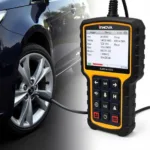Long Term Fuel Trim (LTFT) is a critical parameter displayed on your OBD2 scanner that provides valuable insights into your vehicle’s fuel management system. Understanding LTFT OBD2 readings can be incredibly helpful in diagnosing and addressing potential engine performance issues.
What is LTFT on an OBD2 Scanner?
Your car’s engine needs a precise balance of air and fuel for optimal performance. The Engine Control Unit (ECU), the brain of your vehicle, constantly monitors and adjusts this air-fuel ratio using data from various sensors, including the oxygen sensor. LTFT is one of the parameters the ECU uses to fine-tune the air-fuel mixture over extended periods.
Essentially, LTFT is a percentage that reflects how much the ECU has had to adjust the fuel delivery to maintain the ideal air-fuel ratio. A positive LTFT value indicates the engine is running lean (too much air, not enough fuel), while a negative LTFT value suggests a rich condition (too much fuel, not enough air).
How to Read LTFT OBD2 Values
Most OBD2 scanners will display LTFT as a percentage. Here’s a general guideline:
- -10% to +10%: This range is generally considered acceptable and indicates the fuel system is functioning within normal parameters.
- +10% to +25%: A consistently high positive LTFT suggests a lean condition, which could be caused by a vacuum leak, faulty oxygen sensor, or low fuel pressure.
- -25% to -10%: A consistently high negative LTFT suggests a rich condition, possibly due to a clogged air filter, malfunctioning fuel injector, or a faulty coolant temperature sensor.
- Outside the -25% to +25% Range: Readings outside this range usually signal a more serious problem and require immediate attention from a qualified mechanic.
Common Causes of High LTFT Readings
- Vacuum Leaks: A leak in the intake manifold or other vacuum-operated components can disrupt the air-fuel mixture, leading to a lean condition.
- Faulty Oxygen Sensor: The oxygen sensor plays a crucial role in measuring the oxygen content in the exhaust gases, providing data to the ECU for fuel adjustments. A malfunctioning sensor can lead to inaccurate readings and improper fuel trim adjustments.
- Fuel Delivery Issues: Low fuel pressure due to a weak fuel pump, clogged fuel filter, or restricted fuel lines can cause a lean condition.
- Dirty Mass Air Flow (MAF) Sensor: The MAF sensor measures the amount of air entering the engine. A dirty or faulty MAF sensor can send incorrect data to the ECU, affecting fuel trim values.
- Clogged Air Filter: A severely restricted air filter can choke the engine’s air supply, leading to a rich condition.
Why Monitoring LTFT is Important
Monitoring your LTFT values can help you:
- Identify Potential Problems Early: Detecting fuel trim issues early on can prevent more serious engine damage and costly repairs.
- Improve Fuel Economy: An engine running at the optimal air-fuel ratio will generally achieve better fuel efficiency.
- Enhance Engine Performance: Addressing fuel trim problems can lead to smoother idling, better acceleration, and overall improved engine performance.
When to Seek Professional Help
While you can monitor LTFT yourself using an OBD2 scanner, it’s crucial to consult with a qualified mechanic if:
- You notice consistently high or low LTFT values.
- You experience other engine performance issues like rough idling, hesitation, or decreased fuel economy.
- You suspect a more serious underlying problem.
Understanding LTFT: Key Takeaways
LTFT is a valuable tool for understanding your engine’s fuel management system. By monitoring this parameter, you can gain insights into potential issues and ensure your vehicle is running efficiently. However, diagnosing and repairing complex engine problems often requires specialized knowledge and equipment. Don’t hesitate to reach out to a trusted mechanic for assistance if you’re unsure about any aspect of your engine’s health.
Need Help with OBD2 Scanners or Car Diagnostics?
Contact us via WhatsApp: +1(641)206-8880 or Email: [email protected]. Our expert team is available 24/7 to assist you.


